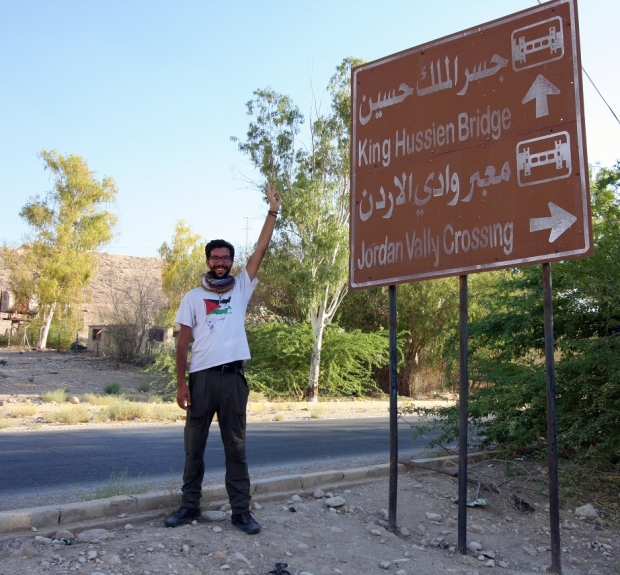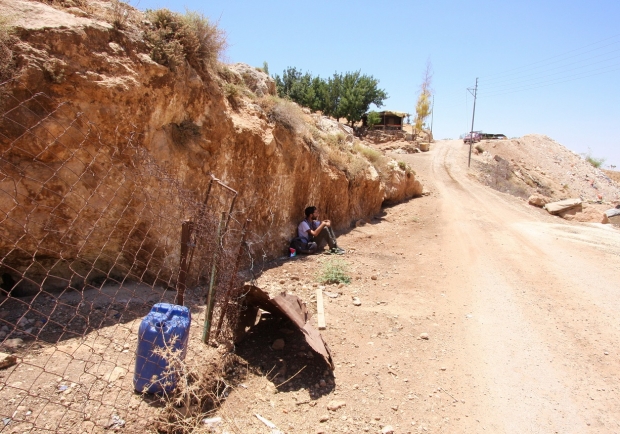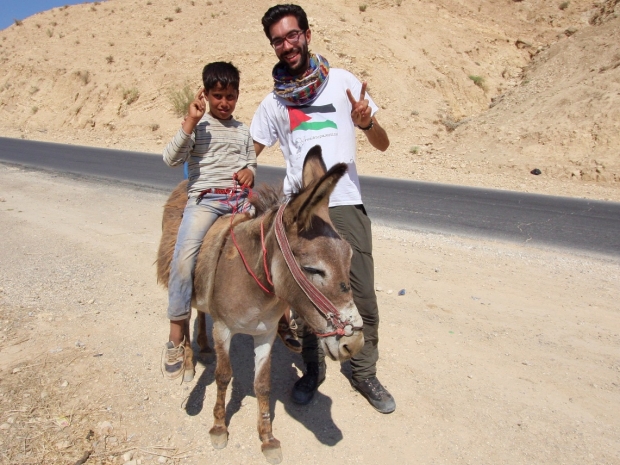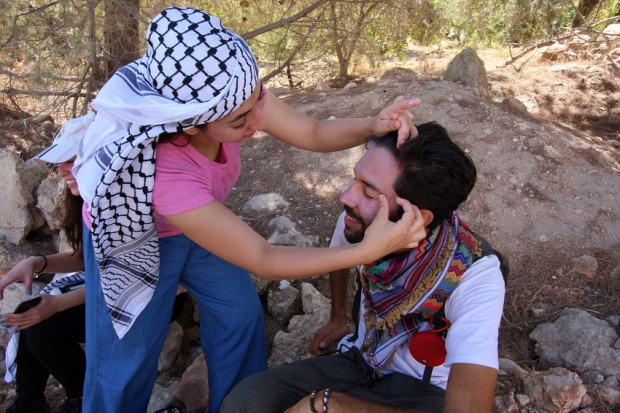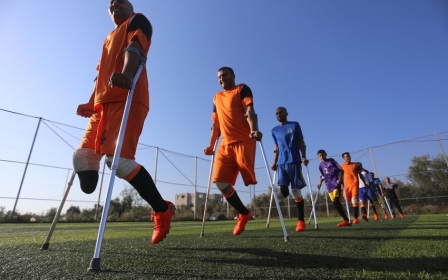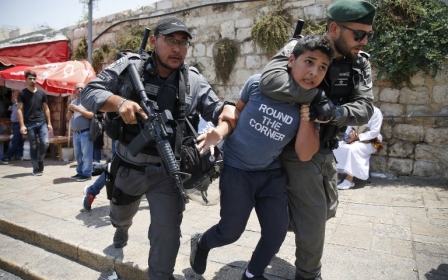Walking for Palestine: Swedish activist’s 5000km trek for justice

AMMAN – By the time Benjamin Ladraa reaches the border of Jordan and Palestine, the dark peaks of the West Bank mountains stand proud against the evening’s pink sky. It has been a long and hot day, but he has finally made it – with some extra people in tow.
I just keep having hypothetical conversations with Israeli soldiers in my head
- Benjamin Ladraa, activist
This final stop is what Ladraa’s entire journey had been building up to since he first set off on a 5,000km walk from Gothenburg, Sweden to Palestine, at the beginning of August last year. It is also the day he anticipates an intense interrogation from Israeli border guards in his attempt to cross into the West Bank via the Allenby Bridge.
“I just keep having hypothetical conversations with Israeli soldiers in my head,” he says, sipping on orange juice as he takes a few minutes to rest. He is clearly anxious about the interrogation he expects to undergo on the other side of the Jordan River.
At 8:30pm on Thursday, he hugs the diverse group of people from many countries that has tagged along with him. He says goodbye and sets off to cross the border.
There is a Palestinian village that has been destroyed more than 100 times by the Israeli army, but the people there are so resilient they just keep rebuilding their homes
- Benjamin Ladraa, activist
Seven-and-a-half hours later, at around 4am, he was refused entry. According to Ladraa, the Israeli border guards said they believed he was lying about his reason for visiting Palestine - which he says is not true - and also because they believed he would incite demonstrations.
Ladraa says the ultimate goal behind his challenge has been to raise awareness about the illegal Israeli occupation of Palestine, in the hope of igniting change for those who suffer under it.
11 months on the road
At 6:30 am, on Thursday morning, Ladraa tucked into a traditional Jordanian breakfast dish of foul madamas (fava beans) in a hotel located in the capital Amman, ahead of a 40km walk in stifling 40-degree heat.
The atrocities committed by the Israeli forces are on a scale which is unimaginable, so we need to talk about it
- Benjamin Ladraa, activist
The Swedish activist’s calm and quietly spoken manner, alongside his ability to rarely let nerves get the best of him, suggests that he is older than his 25 years. However, today he admits feeling anxious about what lies ahead.
“This is the first time I’ve felt nervous in a long time,” he says. “Today could be crazy.”
It has been a long and difficult journey. He has battled the extreme weather conditions of all four seasons, faced a shortage of food in remote areas – often having to set off on an empty stomach and even going without food for two days on one occasion – as well as almost daily questioning by police.
“Monsters thrive in darkness and it is clear by the new law being discussed which would make it illegal to photograph or film Israeli soldiers that the occupation has a lot to hide,” he says. “The atrocities committed by the Israeli forces are on a scale which is unimaginable, so we need to talk about it.”
'The stories people have no idea about'
Ladraa first became interested in the occupation three years ago after befriending a group of Palestinians in Sweden, spurring him into research on Israel's human rights violations.
"The stories I was reading were totally absurd. Everything you discover you just can’t believe it, so I wanted to see it for myself," he says.
His decision to undergo the gruelling year-long challenge was prompted by a three-week trip to Palestine in 2017. He had managed to enter the country after a brief one-hour interrogation at the time.
Every Palestinian I’ve ever spoken to has been arrested and every one of them knows someone who was either tortured or murdered by occupation forces
- Benjamin Ladraa, activist
“There is no substitute for actually visiting a place. Whatever you think you know about something, if you haven’t been there, you don’t know about it,” he says.
According to Ladraa, his visit taught him about Palestine’s restricted water supply, which is controlled by Israel. He also learned that although an earthquake in 1927 damaged many of the soap factories in Nablus’s Old City, it was the Israeli offensive in 2002 and closures imposed by the occupation that did the greatest damage to its once-thriving soap industry.
"Every Palestinian I’ve ever spoken to has been arrested and every one of them knows someone who was either tortured or murdered by occupation forces,” says Ladraa.
Through his talks, Benjamin aims to inform people about the history and the current situation affecting people living in the West Bank and Gaza: from the Nakba, known as the "catastrophe" – when Israel forcibly displaced more than 750,000 Palestinians from their homes in 1948, to the fishing restrictions, the jailing of children, the restriction of movement and the house demolitions.
“There is a Palestinian village that has been destroyed more than 100 times by the Israeli army, but the people there are so resilient they just keep rebuilding their homes,” he says, referring to al-Araqib village. “And it is these stories people have no idea about.”
Tensions have soared in Gaza since 30 March, when Israel met largely peaceful mass protests near the fence separating Israel from Gaza with lethal force, killing at least 133 Palestinians - including 16 children, while 15,200 others have been injured, according to the Palestinian Ministry of Health in Gaza. Two journalists covering the protests were also shot and killed. There have been no Israeli fatalities.
A bittersweet journey
Ladraa’s journey pushed him to his limits on numerous occasions. In Lebanon’s capital Beirut, he was hit from behind by a car in the middle of the day on 18 June, as he walked listening to an audio book titled Rise and Kill First: The Secret History of Israel's Targeted Assassinations by Ronen Bergman.
He ended up in hospital with severe bruises and suffered a great deal of pain as he walked on his journey for two weeks after the incident. But it is loneliness that has been his biggest challenge.
“Spending days at a time on my own has been so tough,” he says. “You get bored, you only have yourself to keep you motivated, and you have to face difficulties on your own.
“On one occasion I got completely lost in the Serbian mountains. It was getting late. I could hardly push my 30kg gear through the snow and I was stuck for about two hours. It was hell.”
"I met lots of amazing people but one guy in particular was a journalist I met in Slovenia who later came to visit me in Istanbul for a week. The pair of us just really connected,” he says.
Spending days at a time on my own has been so tough
- Benjamin Ladraa, activist
As he walks through Amman's streets choked by exhaust fumes, before the dense city’s pale-stoned buildings make way for a sparser landscape dotted with trees, he is joined by friends and supporters who come and go throughout the day.
Manar Nababteh, a 20-year-old Palestinian who lives in Amman, is among the supporters walking with Ladraa today.
“I think a lot of Palestinians feel hopeless and as though change is not possible,” she says. “The fact he is doing this for us is the reason why I have joined him – to show solidarity.”
I have struggled to find places to sleep, food to eat and faced threats of violence along the way, but the unbelievable amount of kindness I’ve been shown makes it all worthwhile
- Benjamin Ladraa, activist
“Walking in extreme heat is tough,” says Ladraa. “At least in the freezing cold you can add more layers and you are moving so there are ways to get warmer. In the heat there is nothing you can do; you just have to grit your teeth and bear it.”
As he takes a break under the shade of a tree, a lady approaches. Without saying a word, she hands Ladraa a plastic bag filled with water bottles, before heading back in the direction she came from.
“This is what makes the challenge worthwhile,” he says. “Little moments like this.
“I have struggled to find places to sleep, food to eat and faced threats of violence along the way, but the unbelievable amount of kindness I’ve been shown makes it all worthwhile.”
Familiar faces
While in Lebanon, he visited 10 out of the 12 refugee camps there, and in Jordan he went to three refugee camps and King Hussein Medical Centre where Palestinians who were injured during the recent Gaza protests receive treatment.
He said witnessing the maiming suffered by boys as young as 16 who have been shot in the legs by Israeli forces was overwhelming.
“I’ve heard people say the Israelis are being merciful by shooting protestors in the legs because it doesn’t kill them,” says Ladraa. “But those type of bullets do indescribable damage to people’s limbs. Only the lucky ones make it to hospitals here; the rest often lose their legs.”
In May, he even came face-to-face with Turkey’s President Recep Tayyip Erdoğan at an International Mount of Olives Peace Awards ceremony, where Ladraa was presented a peace award for his work in raising awareness about the occupation of Palestine. During the event, he gave a speech outlining the need for international governments to put pressure on the Israeli government and end financial support.
While Ladraa is disappointed he didn’t get a chance to spend time with the people in Palestine and see the places he has been talking about, he says the experience has been a liberating one.
Before setting off from Sweden he had been studying Global Studies and working part time at the Red Cross. Ladraa’s intention now is to keep on talking about Palestine and his experience at universities in the hope of inspiring others to make a stand.
“For me, it’s not about doing one thing and then saying ‘that’s enough’. Doing activism is a way of living,” he says.
Middle East Eye propose une couverture et une analyse indépendantes et incomparables du Moyen-Orient, de l’Afrique du Nord et d’autres régions du monde. Pour en savoir plus sur la reprise de ce contenu et les frais qui s’appliquent, veuillez remplir ce formulaire [en anglais]. Pour en savoir plus sur MEE, cliquez ici [en anglais].


